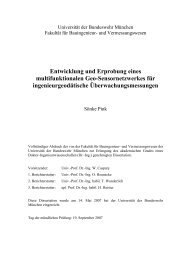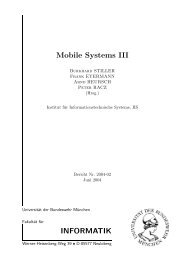Satellite Orbit and Ephemeris Determination using Inter Satellite Links
Satellite Orbit and Ephemeris Determination using Inter Satellite Links
Satellite Orbit and Ephemeris Determination using Inter Satellite Links
- No tags were found...
You also want an ePaper? Increase the reach of your titles
YUMPU automatically turns print PDFs into web optimized ePapers that Google loves.
State Estimation<strong>Inter</strong> <strong>Satellite</strong> <strong>Links</strong>Calculating the partial with respect to position <strong>and</strong> velocity, the part of the a satellitesdynamic matrix considering only position <strong>and</strong> velocity errors can therefore be expressed byFSat⎡ 0⎢⎢0⎢ 0⎢2xkGM⎢−(1 − 3 )2 3= ⎢ rkrk⎢⎢xkyk3 GM5⎢ rk⎢⎢ xkzk3 GM⎢ 5⎣ rk000xkyk3 GM5rk2ykGM− (1 − 3 )2 3rkrkykzk3 GM5rk000xkzk3 GM5rkykzk3 GM5rk2zkGM− (1 − 3 )2 3r rkk1000000100000⎤0⎥⎥1⎥⎥0⎥⎥⎥0⎥⎥⎥0⎥⎥⎦Eq. 3.3-9An other way would be to compute the Jacobian directly, either analytically or by means ofcomputing the partials numerically. The possible length of the transition interval (<strong>and</strong>therefore the orbit arc) is nearly unlimited, thus enabling long integration times.Unfortunately, the analytical solution is restrained to very simple orbit models. The numericalsolution is the most accurate, because the state propagation is computed <strong>using</strong> the non linearforce model. A drawback is the high computational burden, because for n states, the trajectoryhas to be propagated n+1 times. One trajectory is derived from the nominal state at epoch t k-1 ,<strong>and</strong> n trajectories are computed by adding a small increment on each of the states, as indicatedin Eq. 3.3-10.X0,k= f (xk 1,yk1,zk1,xDk 1,yDk 1,zD,....)Eq. 3.3-10− − − − − k−1Xx,k= f (x x, y , z , xD, yD, zDk−1+ ∆k−1k−1k−1k−1k−1,....)Xy,k= f (xk−1,yk−1+ ∆y,zk−1,xDk−1,yDk−1,zDk−1,....)Xz,k= f (x , y , z z, xD, yDk 1 k 1 k 1k 1 k 1,zD− − −+ ∆− − k−1,....)Xx,k D = f (xk 1,yk1,zk1,xDk 1x, D yDk 1,zD− − − −+ ∆− k−1,....)Xy,k D = f (xk 1,yk1,zk1,xDk 1,yDk 1+ ∆y,D zD− − − − −k−1,....)Xz,kD = f (xk 1,yk1,zk1,xDk 1,yDk 1,zDk 1+ ∆z,....)D− − − − − −...The transition matrix is then simply derived by subtracting the appropriate state at t k , resultingfrom the modified state at epoch t k-1 <strong>and</strong> the nominal state <strong>and</strong> dividing by the increment.Page 12R. Wolf
















